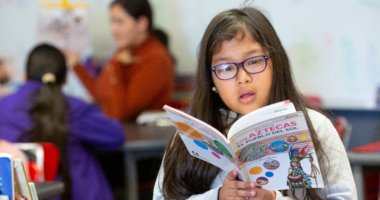Students Who Need the Most Continue to Get the Least
Ed Trust analyzed the most up-to-date national data sources available to examine the state of funding equity across the U.S. and within each state. The report looks at revenues from state and local sources only, excluding federal funds since those dollars are intended — and targeted — to provide supplemental services to traditionally underserved groups. This report focuses on how states allocate the resources that originate from their coffers.
The analysis shows great variation among states in terms of their funding patterns. Illinois, with the largest funding gap in the nation, stands out for its unfairness. The highest poverty districts in the state get nearly 20 percent less per student than the lowest poverty districts. Following Illinois with the largest funding gaps are New York (with a 10 percent gap), Pennsylvania (8 percent), Texas (7 percent), Maryland (7 percent) and Michigan (6 percent).
Yet, there are many states that defy these patterns and show inequities are not inevitable. In Ohio and Minnesota, for example, the highest poverty districts receive about 22 percent more state and local dollars per student than their lowest poverty counterparts. Other states where low-income districts get substantially more dollars include Delaware, South Dakota, Indiana, and Tennessee.
These figures look at whether the funding that high- and low-poverty districts receive is equal, failing to take into account that it costs more to educate a student in poverty than a student not in poverty. When we adjust for the added costs of educating low-income students and ask whether funding is equitable, the trends look far worse. Nationally, the funding gap between the highest and lowest poverty districts grows to $2,200 per student, or 18 percent. Moreover, the number of states that provide high poverty districts with substantially less funding grows from 6 to 22.
Importantly, inequities in funding don’t only occur based on poverty. In fact, Ed Trust analysis finds inequities for districts serving the largest populations of African American, Latino, or Native students to be more prevalent, and more substantial, than those based on poverty. Nationally, districts serving the most students of color receive about $2,000, or 15 percent, less per student than districts serving the fewest. And while in 14 states districts that serve the most students of color receive substantially more money, in 18 states, they receive substantially less.
“If this nation is truly to live up to its promise of being the ‘land of equal opportunity,’ states must take a hard look at their funding formulas and ask themselves, ‘Are we giving all students the resources they need to reach their full potential?’ The answer is ‘no’ in far too many states,” said Natasha Ushomirsky, K-12 senior data and policy analyst and co-author of the report. “The good news is that closing funding gaps is possible. There are many states that are paving the way.”
# # #









